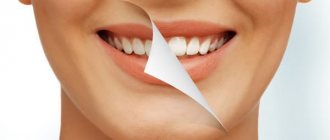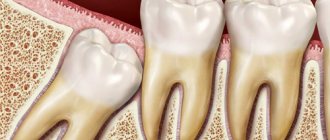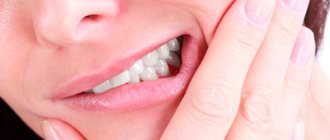Pain when brushing your teeth is common. And often it does not depend on what kind of brush you use - manual or modern electric. In this article we will tell you why teeth can hurt during daily hygiene procedures and what needs to be done in such a situation.
In this article
- It hurts to brush your teeth - what could this mean?
- Why does it hurt to brush healthy teeth if you have hypersensitivity?
- What to do if brushing your teeth hurts?
Why do you need professional teeth cleaning?
Diligent oral care does not exclude the formation of tartar, pigmentation and plaque. Everything that remains on the teeth after hygiene procedures mineralizes over time, forming hard particles. They hold on so tightly that it is not possible to remove them with a thread or brush.
Professional sanitation is carried out using different methods. It is impossible to say for sure which teeth cleaning is better. When choosing a method, the following factors are taken into account:
- oral health;
- the presence of pathological processes;
- contraindications to the use of a particular technique;
- availability of consumables in the clinic.
The importance of the procedure is to prevent the development of the carious process. It is the stone formed on the enamel that damages the bone tissue. This leads to tooth decay. Among other things, the pathology quickly spreads to neighboring units.
Many people are interested in how often to brush their teeth. It is enough to visit the dentist for high-quality oral hygiene twice a year. If you have problems with your gums, it is recommended to make an appointment for cleaning once every 3 months.
What the procedure provides:
- enamel whitening, dark stain removal;
- cleaning from mineralized deposits and dense deposits;
- prevention of caries, inflammatory gum diseases, including you may not need further treatment of periodontitis;
- preparation for complex dental treatment (fixed dental prosthetics, implantation, bite correction);
- eliminating unpleasant odor coming from the mouth.
Why does enamel wear off?
Minor deformations do not lead to the development of hyperesthesia, but the longer the disease develops, the more painful the consequences. Common reasons why enamel wears off:
- calcium absorption disorders;
- poor nutrition;
- genetic disorders;
- pathology of the thyroid gland.
There may also be congenital defects that lead to a thinning of the protective layer with age. The cause may be bad habits, increased consumption of fiber-depleting drinks, and smoking tobacco. The process can be affected by improper treatment, contact of the crown with the walls of the teeth, incorrect installation of the prosthesis or braces.
Having found out the reason why the enamel on the teeth is worn away, the doctor can choose a treatment. The patient may notice changes before pain appears. Discomfort appears when eating cold, hot, or sweet foods. Sensitivity gradually increases, roughness and thinning appear. The surface darkens and characteristic layers form.
Types and differences of professional teeth cleaning
There are various ways to clean your mouth professionally. Each option has advantages and disadvantages. The choice of technique is made by the dentist.
Ultrasonic
It is performed using a special device - an ultrasonic scaler. The working element of the device is equipped with a nozzle that performs oscillatory movements at an ultrasound frequency of 25-50 kHz. The effect is enhanced by supplying an antiseptic solution or water through the nozzle. Deposits are removed under the influence of cavitation.
This method does not damage the enamel. When treating the oral cavity with an antiseptic, pathogenic bacteria are destroyed. The effectiveness is so high that it is possible to cope even with supra- and subgingival stones. The patient does not feel pain after brushing his teeth.
Laser
Removal of mineral deposits and plaque from the surfaces of the oral cavity is carried out under the influence of a laser beam. The liquid evaporates from them, as a result of which the destruction process begins. Peeled particles are removed with a stream of water supplied under high pressure.
The cost of the service is higher than alternative methods, due to the use of expensive equipment.
Sandblasting
Cleaning is performed using Air Flow equipment. The device even copes with old deposits. The main condition is that the coating must be soft. Air Flow does not remove tartar. The process of sanitation of the mouth involves the use of a special attachment, a mixture containing a fine abrasive, and a fixing gel. This method is used with caution in cases of increased sensitivity of the gums.
Chemical
The essence of the procedure is to apply a special gel containing hydrogen and acid to the teeth. During aging of the product, hard and soft deposits are destroyed under the influence of chemicals.
The method is painless and effective. But the interdental areas are poorly treated.
Mechanical
Sanitation is carried out using brushes and highly active pastes. This method requires more time than alternative options. But the result is high. However, in the process of mechanical impact with brushes, the risk of damage to the enamel increases. For this reason, specialists rarely resort to such cleaning.
How to preserve tooth enamel
It is important to know how to care for tooth enamel to prevent the development of pathologies. Experts give advice on how to preserve tooth enamel and not cause deformation. It is necessary to adjust your diet, consume sufficient amounts of protein, calcium, fluoride and vitamin D. It is recommended to reduce sugar consumption and stop smoking.
Dentists recommend giving up the bad habit of chewing pens, pencils, and brushes. Clean daily with a soft brush that does not damage the gums. It is important to remove plaque and food particles using dental floss. Regular visits to the dentist will help prevent the development of hyperesthesia.
If a person has weak protection from nature, then it is possible to undergo a remineralization procedure according to indications. A special composition will protect the surface and reduce sensitivity. Those who regularly experience seasonal manifestations of hyperesthesia are recommended to regularly cleanse with special pastes to instantly reduce sensitivity. A medical specialist may suggest installing veneers not only to correct position and color, but also to reduce pathological sensitivity.
Contraindications to the procedure
Like any medical procedure, teeth cleaning in a dental clinic has a number of limitations:
- increased sensitivity;
- the presence of erosion processes on the enamel;
- inflammation of the oral mucosa;
- history of arrhythmia;
- epilepsy;
- acute infectious diseases;
- diabetes;
- bronchial asthma, occurring in severe form;
- chronic rhinitis (including runny nose due to ARVI).
Ultrasound and Air Flow services are available to patients over 14 years of age.
Additional oral cleansing
Oral hygiene is not limited to two rows of teeth. For complete cleansing it is necessary to treat: • Interdental spaces. Dental floss or a brush will help remove plaque. • Language. To do this, use the relief surface of the back of the toothbrush or a special scraper. • Gums. They are partly cleaned with a brush: at an angle of 45 degrees, the bristles approach the edge and capture deposits. Rinse aid also helps. • Cheeks. You can go over them with the back of the brush, but they require more rinsing.
You need to start by removing the largest food debris. To do this, just rinse your mouth with water. Then comes the turn of fragments stuck in the interdental spaces - this is where floss comes to the rescue. Now you can take up the brush with the paste. Rinse aid is used last - to create a protective layer.
Stages of the procedure
Professional sanitation of the oral cavity is carried out in stages.
Stage 1: Comprehensive inspection
It is performed using modern instruments to identify deposits and assess the condition of tissues.
Stage 2: removal of soft and hard formations
To obtain high results, two methods are combined: ultrasonic cleaning and Air Flow. The first option destroys the structure of tartar, the second removes plaque and remaining stone.
Stage 3: Polishing
The enamel is polished using special brushes and paste. The surface is smooth and shiny.
Stage 4: fluoridation
To protect bone tissue, a gel or varnish containing a high concentration of fluoride is used.
How do children brush their teeth?
Ultrasonic cleaning and Air Flow are not prescribed for children under 14 years of age. Professional sanitation of the oral cavity is performed using special brushes and paste. After dental treatment, the surface is coated with fluoride-containing gel to strengthen the enamel.
Recommendations for caring for an electric toothbrush
An electric toothbrush has very soft and delicate bristles, which easily become dirty and therefore require careful care. To ensure that the brush is always absolutely clean, dentists recommend that after use, rinse it under a strong stream of hot water and then soap it. The soap can be washed off after a while or just before cleaning.
The brush must be dry before it is placed in a special case or glass. It is strictly prohibited to store a wet brush in a closed case to avoid the development and proliferation of bacteria and, consequently, the subsequent use of an electric toothbrush .
Some models provide for replacing the head with bristles, but in any case, if the question arises: how often should you change a toothbrush, doctors at our medical center strongly advise replacing the brush or bristles more than once within three months. In new models, the bristles are designed to last from 1 to 12 months, but this does not mean that replacement must be made after a year. Make sure to promptly follow this recommendation for reasons of benefit and hygiene, especially since some expensive models provide a wear indicator that will indicate the need for replacement.
Is it painful to have professional cleaning?
Patients often wonder if it hurts to have their teeth cleaned at the dentist. Regardless of the method used, there is no pain. A feeling of discomfort may occur when removing mineralized formations. In this case, ultrasound is prescribed. Ultrasonic teeth cleaning is also recommended during pregnancy and increased tooth sensitivity.
Characteristics of electric brushes
Electric toothbrushes, first released in the 60s of the last century, are popular among dental care methods. Electric toothbrushes provide automatic vibration with a large number of movements per second, which a person is not able to repeat. Thanks to automatic movements, caring for teeth is easy and children also find it interesting.
Modern types of electric brushes differ favorably in many respects from their first analogues. The main characteristics of various models include:
- Soft pulsation of reciprocating movements;
- Several cleaning speeds, for example, lower for sensitive areas of gums and teeth;
- The great benefit of an electric toothbrush is its ergonomic shape, which makes cleaning easy for users of all ages;
- Partially reconfigurable for maneuverability and increased stability in the mouth;
- Provided change of nozzles;
- Reliable battery with charging indication.
Reasons why gums bleed
Blood during brushing indicates problems with the periodontium - the tissues that surround the tooth and hold it in the jaw. Bleeding often occurs in adolescents and pregnant women, which is associated with hormonal changes in the body. As a rule, this goes away over time without consequences. But it is better to visit the dentist during this period so that the problem does not return later.
Basically, gums bleed due to diseases in the periodontal tissues, such as gingivitis, periodontitis and periodontal disease. These diseases are characterized by inflammation of the gums, which progresses over time and can lead to tooth loss. Only timely consultation with a doctor, prevention and treatment of gums will help here.
Bleeding and inflammation of the gums are caused by pathogenic microorganisms that multiply in the mouth due to poor hygiene and bad habits. Bacteria easily enter the gums with food, penetrate the film that protects the periodontium, and cause plaque and tartar. Deposits on the teeth make their way under the gums, expanding the so-called pockets, and the capillaries become thinner. Because of this, even with minor mechanical impact, the tooth bleeds. This is why gums bleed when brushing your teeth.
In what cases is pain after canal cleaning not normal and what to do?
If the pain does not subside within several days and does not decrease, this may indicate complications or that the treatment was carried out incorrectly.
When pain is a symptom of pathology:
- if the pain does not decrease within several days;
- if the pain increases;
- for acute and throbbing pain;
- swelling and severe swelling of the gums;
- increased body temperature;
- general deterioration of health.
In these cases, you should immediately consult a doctor; there are complications after treatment.
Abnormal pain can result from a number of factors:
- a mistake made during treatment;
- poor-quality cleaning of the canal - repeated opening and cleaning is required;
- a fragment of a tooth or instrument remains in the canal cavity;
- individual intolerance of the body, allergy to components in the filling material or medications;
- poor-quality placement of the filling or the filling material protrudes above the surface of the tooth;
- inflammation of periodontal tissue – the infection has spread from the pulp to the gum;
- perforation of the canal walls due to accidental movement of the instrument;
- during the treatment the tooth root was touched and damaged;
- penetration of infection and development of re-inflammation.
In all these cases, inspection, diagnosis, identification of the problem and its prompt elimination are required.
If you ignore the symptoms for a long time and postpone a visit to the dentist, this can increase the inflammatory process and ultimately lead to the need for tooth extraction. Moreover, an infection that is not eliminated in time can spread to neighboring teeth, causing inflammation and the development of the disease.
In no case should you try to fix the problem yourself, much less apply heat compresses to the affected area, take hot food or alcohol - this stimulates the development of inflammatory processes and suppuration. The only solution to the problem is an immediate visit to the clinic.










